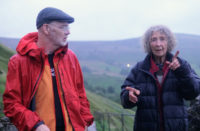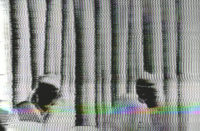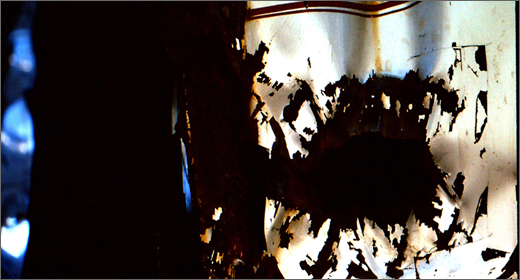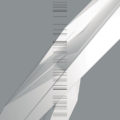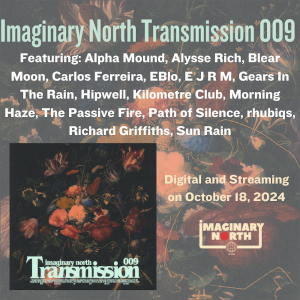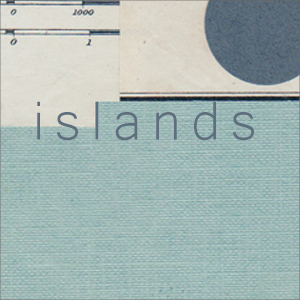
David Chandler of Solenoid has been a busy man lately. Releasing 3 albums on various imprints over the course of a couple of months. He takes a few minutes off to discuss with
Igloo his creative process, his influences and what the future holds for Solenoid..
::..:::…..:..::….:::::..:::..:::::::……:::…::.:::….::::..:..:::…::…….:::::
Igloo When writing tracks what do you think is the biggest obstacle you face?
David Chandler (Solenoid): The most difficult thing for me to do is to always divert myself into new
approaches to composing and overcome any predefined ideas I may already have
about ‘traditional’ or ‘experimental’. I am constantly questioning my own cynical or rational tendencies while
composing and tricking myself into pushing myself to
learn new things about music-making by trying what I don’t know.
Igloo: Describe what your studio is like: analogue, digital ? Organized, disorganized ?
Solenoid: 14′ x 12′, organized such that I can find what I need, though I imagine
it looks very cluttered to other people. Not that it is filled with stacks
of newspaper with narrow aisle ways to walk between like the studio of
that painter, Francis Bacon. I have hardware synths and have used an Atari
ST to sequence with the typical small mixer and dat to handle the rest. I
sometimes use a computer to do post-production work to the final recordings.
I have used the Atari for many years and am very fast to work within Cubase
2.0 for sequencing. That, combined with the fact that I spend more hours
working on music than working a day job, means that I’ve been able to really
learn my tools, repair or modify my synths, teach myself to play instruments
and collaborate with people.
Igloo: What influences outside music do you draw upon?
Solenoid: Film, visual art, time spent with friends, humor, literature, thinking.
I spend a lot of time thinking. I also tend to question everything around
me from practical engineering to aesthetics. I have lots of ideas and tend
to reject nearly every preconceived notion (that I notice in myself) about
what I think I “should” or “shouldn’t” do with music.
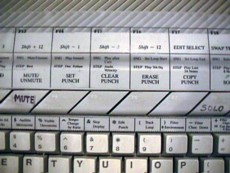
Igloo: Why did you decide to release 3 albums in the span of a couple of months ?
Solenoid: I didn’t decide to do this, it simply happened as a result of the timing of
3 independent album projects coming together and because I’ve produced
hundreds of tracks in the last 10 years without ever pressing my own album.
I almost put out an album in 1995, but I have always been so self-critical
and generally only really made tracks to satisfy my own voracious appetite
to learn about aspects of music, I just was not motivated to share what I
was doing. I’d often forget to do anything but sit down and write and tweak
a new track. After I’d realized that I could take part in a music community and possibly trade for new records instead of always
shelling out cash for them. Also, I’d become interested in getting
feedback. After recording music from about 1989-1995, I
decided that I might be able to get my music on a label, get free records
and then be able to trade for other artists’ records, and thus make my hobby
pay more for its’ growing cost (buying several records a month has always
been more expensive than programming my own music.) I was finding more
interesting music was being released by ’95.
In 1996, I met Deno, who then started the Emanate label. Originally, my
album would have been one of the very first releases, but he kept redoing
the tracklisting every few months when I sent him new tracks, and this went
on for over 2 years. I eventually figured out by the end of ’99 that if I
stopped sending him music, he’d have to make a final selection and stick to
it. Those tracks are almost all from 1999. He made most of the track
selection and ordering decisions, as well as the artwork and format
arrangements. My handing over a lot of control like this is just part of
how I’m dealing with letting go of my being self-critical, otherwise I’d
probably never release anything.
The Outward Music album just happened to get pressed at nearly the same time,
though it is a mix of newer and older tracks (1997-2000) chosen
democratically by the OMCO guys and myself. That album is slightly more
light-hearted and has several tracks that are silly and happy included,
which I am happy about because I have tried to explore music in as many
different ways as fascinate me, and this includes making the most extremely
dark and most extremely light-hearted kinds of melody and sounds. I am
always trying to avoid just doing the same kind of approaches to music over
and over. I don’t believe that exploring a wide range of musical styles
precludes that the music I make will be shallow or any less
experimental.

The HiaoHiaoHiao album, The Narcissist is different in that it is a
collection of similar-approach tracks brought together. The tracks are
all synth-pop/electro tracks spanning 1995-2001. This album came out of the
ashes of the Endpoint label album I was prepared to release 2 years ago
before the label evaporated into thin air. I have always been exploring
this kind of music and have been listening to the roots of this since 1981
when I bought “Dare” by The Human League when I was 11 years old. I credit
this album’s dedication to the concept of generating entirely-synthesized
pop music to my original fascination with synthesizers. Consequently, I
have obsessively followed several genres of electronic music records through
to this day.
I still have about 100 out of 400 tracks I’ve done that would be acceptable
to release, in fact, I just re-mastered and edited some recently.
Igloo: Was your approach different on working on each of the 3 new albums ?
The Narcissist title track is the only track from these albums that I’ve
created specifically to join an planned album. All of my tracks were worked
on as individual tracks. I do not usually follow a pattern in focusing
on a particular kind of track, thus the waltz on the Emanate album might
have been written a week after an electro track on the Hiao album.
I had no knowledge that any track would necessarily go on any album, I just
continued creating a lot of tracks and occasionally gave recordings to the
labels. There is far more unreleased music from these periods than is on
the albums, as the labels just picked and chose, except Reverse Sender
which was democratic, including my votes. Also, I forced Outward Music to
use the short version of Sender only on the 12″ EP of the album.
Igloo: When you start writing a song, do you typically have an idea or concept in mind?
Solenoid: I try to trick myself into trying a new approach or to learn to do
something, like emulate a guitar plucking, compose in a certain time
signature, work around a melody in my head, or sometimes I’m inspired by
just playing with sound design on the synthesizers or from playing drums.
Igloo: What other artists from your area do you identify with ?
Solenoid: From my area? Well, just within Oregon, I’d have to say ML, Not Breathing,
Gadgetto/WillBlack, Monkey+1, N-grava, Mothra, Strategy, Nudge (esp the new
cd, Trick Doubt), my friend… I don’t relate to any of the indie rock bands at all, not
just because they represent a negative, unsupportive atmosphere toward
electro/techno through the 80’s and 90’s, but because even their retro-synth
pop is uninteresting and aloof. My use of synthesizer tones to explore
music was always much more accepted by the conceptual/avantgarde/power-noise
projects on the west coast, like A Nat Hema, Dan Menche, Polar/Nickel, Crawl
Unit, etc. and consequently I performed improvised electronics and efx
through the early 90’s, but not my sequenced music. I’ve also never been
connected with local techno dj’s for the most part, though I relate to
dj’ing as an improv, collage, and avant garde listening activity, not so
much the whole partying thing.

Igloo: What is going on with Office Products ?
Solenoid: Doug (Theriault) and I have been playing more live gigs lately. Because our
duo is improv-based, our playing live is crucial to how we explore music and
refine our repartee’. For Solenoid performances, I have borrowed heavily
from my Office Products setup (sampler controlled by drum pad, foot pedals,
and midi fader box) as I don’t think just playing a recording or adding
theater to a recording directly deals with the issue of how experimental
techno is “performed” live.
There was a period from 95-99 where we played once a week and recorded our
sessions and filed them away, only occasionally playing gigs (Doug has
always traveled and played free-improv with other improvisers the whole
time) We assembled a couple tapes and cds during this time and have been
slowly trying to promote our repressed 1998 cd Business, while we are
compiling a new cd. Archigrammiphone might release a 3″cd of Office
Products in the near future. Doug and I are slow to promote our recorded
music, but we improvise live fairly regularly and I really enjoy doing it.
Office Products recently had a track published on the 3-cd State of the
Union: 2001 compilation put together by Elliot Sharp. We’re glad that our
particular approach to electronic-sounding free-improv/free-jazz(?) is
acknowledged in some way.
Igloo: What are you working on now ?
Solenoid: I have another album on ice, basically, with Audio Dregs. We figured it
would probably not be too smart to put that one out at the same time. I
have slowed down my writing and recording, but i do have a few hours of
tracks made since the albums’ tracklistings were locked down.
I have been collaborating with a composer who studied formal composition in
the academic world and I’ve been building percussion and rearranging
compositions of her piano-based stuff. It is fun to work with composing
detailed percussion around ornate chords. I’m totally not afraid of taking
a ‘maximalist’ approach to music sometimes. Not so much always layering a
lot of sound as just having a lot of complex chord changes, accents,
melody/percussion interaction… maybe that sounds really geeky or even
pretentious, but i don’t think so, as I feel like I don’t know what I’m
doing every step of the way, but I am learning a lot and gaining an
ear for really complex melodic music like bluegrass banjo, baroque music,
harpsichord, classical piano…
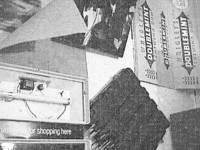
Recently, I have recorded a few ‘exercises’ where I explore emulating
acoustic instruments with digital synthesis and sequencing. I’m not so
concerned with getting them to sound just like the particular instrument so
much as to get a sense of the same range of expression out of the dynamics
and sound from them being physically ‘played’ live. I really reject the
notion that physical instrumentation can’t be emulated electronically. I
don’t think that focus should be spent on the acoustic modeling so much as
the expressive range…matching the acoustics is just a beginning–the
actual accidents and physical interaction of the hand and acoustic
instrument have to be considered. For instance, what kinds of tendencies
during the middle, beginning, end of a bar of guitar strumming are “up” and
“down” strums? I’m messing with things like that and having lots of small
successes that I hope to incorporate into my tracks. Drumming is
a great example of something that is easily reduced to data in terms of
nuance and ‘physical memory’ movements. I’ve also some weird
bazouki/dulcimer/guitar strumming/plucking/chording…also harp, and some
shoe-gazer-type guitar treatments similar to My Bloody Valentine.
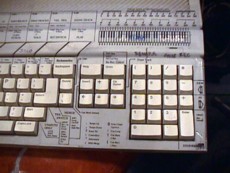
I have been trying to take different approaches to remixing music than just
randomly creating something out of samples or the some melodies. I made a
noisey waltz out of a Loam track for the TopScore label.
Then I did a recent remix of Marumari which ended up being a totally
different approach. It only copies a little part of a riff, around which I
wrote a whole new song–but the driving force of the song was to celebrate
(through creating the right mood) how friendly and carefree (free from
cynicism!) some of his best music is and how honest and happy Marumari music
makes me feel. So the remix is about retaining the mood from listening to
the music without actually going and working around samples or the same
melody of the original source track.
::..:::…..:..::….:::::..:::..:::::::……:::…::.:::….::::..:..:::…::…….:::::
Solenoid’s Reversesender full length is now out on OMCO as well as his Servies Rendered LP with Emanate Records. The Narcissist (on HiaoHiaoHiao) is also available..








